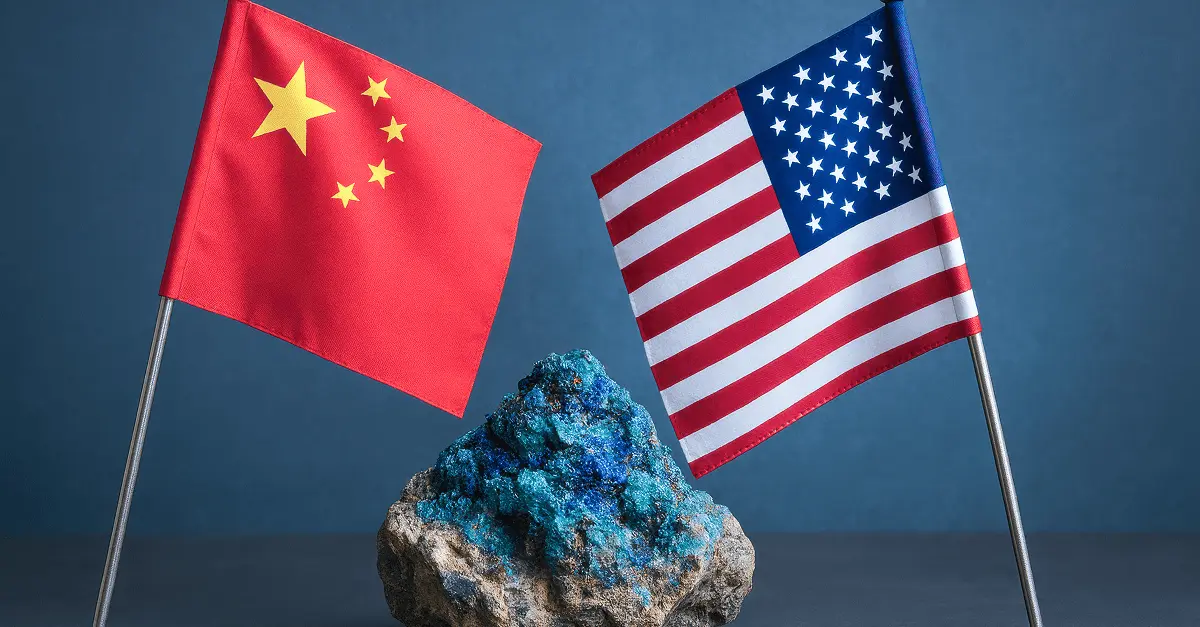5 Critical Minerals Vulnerable Due to China’s Production Control
China’s dominance in producing many critical minerals puts companies at risk of supply disruptions. This summary highlights five key minerals threatened by export controls and their impact on global industries.

Critical minerals are essential to the technologies that power modern manufacturing, from semiconductors and fiber optics to electric vehicles and renewable energy systems. Many of these materials are produced or processed in only a few countries, creating vulnerabilities across global supply chains.
China’s position as the dominant supplier and processor of several critical minerals means its export restrictions can have far-reaching consequences for manufacturing industries worldwide. In recent years, China has used export licensing requirements and other controls to manage the flow of certain minerals to foreign markets, directly influencing availability and pricing.
Below, we examine five critical minerals most at risk from China’s export restrictions and explore their importance to manufacturing, the scale of China’s production, and the potential impacts on global industries.
Why China’s Export Controls Matter for Manufacturing
Critical minerals are defined by their economic importance and the risk of supply disruption. In manufacturing, these materials are foundational to the production of high-performance goods, from consumer electronics to defense systems.
China’s export controls—often implemented through licensing requirements—can limit the availability of certain minerals outside its borders. This can result in:
- Increased material costs for manufacturers.
- Supply chain delays and production slowdowns.
- Urgent searches for alternative suppliers or substitutes.
The U.S. Geological Survey (USGS) notes that the United States is 100% import-reliant on several of these minerals, with China supplying a majority share. This level of dependency means any disruption in Chinese exports can quickly ripple through manufacturing supply chains.
1. Gallium
- China’s role: Produces about 98-99% of the world’s gallium.
- U.S. reliance: 100% reliant on imported gallium, with China the second-largest supplier.
- Manufacturing uses:
- Semiconductors and integrated circuits.
- Light-emitting diodes (LEDs).
- Defense systems and radar.
- Restrictions: In August 2023, China introduced new export licensing requirements for gallium, significantly tightening the flow of this material to foreign buyers. The following year in December 2024, China banned all exports of gallium to the United States.
For electronics and defense manufacturers, gallium is indispensable. It is used in high-frequency and high-power devices that have few viable substitutes. Any delay or price spike in gallium availability could impact production timelines for semiconductors, LEDs, and advanced defense applications.
2. Germanium
- China’s role: Accounts for approximately 60% of global germanium production.
- U.S. reliance: 100% reliant on imported germanium, with China the third-largest supplier.
- Manufacturing uses:
- Fiber optics for telecommunications.
- Infrared optics for night vision and thermal imaging.
- Solar cell applications, including space-based solar panels.
- Restrictions: China first exercised export restrictions on germanium in August 2023 by introducing licensing requirements for exporters shipping the mineral abroad. These restrictions escalated in December 2024, when China banned all germanium exports to the United States.
The USGS warns that these restrictions on germanium could disrupt sectors that depend on advanced optics and telecommunications infrastructure. For renewable energy manufacturing, germanium’s role in high-efficiency solar cells is especially critical. Disruptions to its supply could slow projects in aerospace and energy, where performance and reliability are paramount.
3. Graphite
- China’s role: Produces about 75% of the world’s graphite production.
- U.S. reliance: 100% reliant on imported graphite, with China the largest supplier.
- Manufacturing uses:
- Anodes in lithium-ion batteries for EVs.
- Fuel cells and energy storage systems.
- Industrial lubricants and refractory materials.
- Restrictions: To diversify auto supply chains away from China, the Biden Administration implemented the 2022 Inflation Reduction Act (IRA), which tightened rules for automakers to qualify for EV tax credits by requiring critical minerals like graphite to come from the U.S. or countries with free trade agreements.
This restriction was further impacted in October 2023 when China introduced export permit requirements for certain graphite products, making access even more difficult.
These rules, which took effect in early 2023, combined with China’s restrictions, created challenges for the automotive industry. In May 2024, the U.S. Treasury eased these rules by allowing some automakers to continue sourcing graphite and other minerals from China until 2027.
Graphite remains a key point in the U.S.-China trade tensions, and limited access may impact EV production, battery prices, and the clean energy transition.
4. Antimony
- China’s role: The largest global producer of mined antimony.
- U.S. reliance: 100% reliant on imported antimony, with China the largest supplier.
- Manufacturing uses:
- Flame retardants in plastics and textiles.
- Alloys for lead-acid batteries.
- Semiconductor applications in certain optoelectronic devices.
- Restrictions: In December 2024, China banned all exports of antimony to the United States.
Antimony’s flame-retardant properties make it critical for manufacturing electronics, construction materials, and consumer goods that must meet fire safety standards. The USGS identifies antimony as a mineral with a high supply risk due to limited global production outside China.
5. Rare Earth Elements (REEs)
REEs are a subset of critical minerals and play a vital role in electronics manufacturing. While not all critical minerals are REEs, all REEs are critical minerals.
- China’s role: As of 2023, China produces about 70% of rare earths globally.
- U.S. reliance: 100% reliant on imported REEs, with China the largest supplier.
- Manufacturing uses:
- Electric vehicle (EV) motors.
- Wind turbine generators.
- Smartphones, speakers, and other electronics.
- Restrictions: In April 2025, China imposed export controls on seven rare earth elements—samarium, gadolinium, terbium, dysprosium, lutetium, scandium, and yttrium-related items—as part of its response to President Trump's decision to raise tariffs on most Chinese products to 54%. These restrictions require exporters to obtain licenses from China's Ministry of Commerce, effectively limiting global access to these critical materials.
Rare earth elements are a group of 17 minerals vital to clean energy technologies and consumer electronics. Because REEs are difficult and costly to produce outside China, manufacturers in the automotive and green energy sectors remain vulnerable to policy changes that could limit Chinese supply.
Global Ripple Effects of China’s Export Restrictions
The effects of export restrictions on these minerals extend far beyond individual industries. Because many manufacturing sectors share the same material inputs, a disruption in one mineral’s supply can create cascading effects:
- Cost increases for downstream products such as EVs, electronics, and renewable energy equipment.
- Production slowdowns as manufacturers wait for alternative supplies or qualify substitute materials.
- Geopolitical tensions as countries compete for access to constrained resources.
How Manufacturers Can Mitigate Critical Mineral Risks
While dependency on Chinese exports is unlikely to be resolved quickly, manufacturers can take steps to reduce their exposure to supply disruptions:
- Diversify suppliers: Source from multiple countries where possible.
- Increase stockpiles: Build strategic inventories of high-risk minerals.
- Invest in recycling: Recover critical minerals from end-of-life products.
- Explore substitutions: Develop materials or designs that reduce reliance on scarce inputs.
- Strengthen supply chain visibility: Use monitoring tools to track mineral flows and policy changes in real time.
These strategies can help manufacturers manage uncertainty while longer-term efforts—such as new mining projects or processing facilities—work toward reducing dependency.
The Road Ahead
China’s role in producing and processing critical minerals means that its export restrictions will continue to influence manufacturing supply chains globally. For manufacturers, understanding which materials are most at risk and developing contingency plans is essential.
Gallium, germanium, rare earth elements, graphite, and antimony represent five minerals where export restrictions could have immediate and significant effects on production. By preparing for potential disruptions now, manufacturers can better navigate the challenges of a concentrated and strategically sensitive supply chain.
Access to critical minerals is no longer simply a procurement concern—it is a strategic imperative for the future of manufacturing.
Get Visibility with Z2Data
Z2Data provides manufacturers and supply chain teams with detailed, up-to-date intelligence on critical minerals, supplier dependencies, and potential risks across their supply networks. From tracking regulatory changes to identifying alternative sources, our platform delivers the data and insights needed to strengthen supply chain resilience and maintain operational continuity.
Learn more about how Z2Data can help safeguard your manufacturing operations against critical mineral disruptions.
The Z2Data Solution
Z2Data is a leading supply chain risk management platform that helps organizations identify supply chain risks, build operational resilience, and preserve product continuity.
Powered by a proprietary database of 1B+ components, 1M+ suppliers, and 200K manufacturing sites worldwide, Z2Data delivers real-time, multi-tier visibility into obsolescence/EOL, ESG & trade compliance, geopolitics, and supplier health. It does this by combining human expertise with AI and machine learning capabilities to provide trusted insights teams can act on to tackle threats at every stage of the product lifecycle.
With Z2Data, organizations gain the knowledge they need to act decisively and navigate supply chain challenges with confidence.


.svg)






